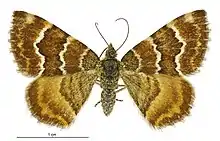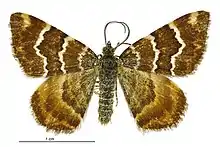Notoreas niphocrena
Notoreas niphocrena is a species of moth in the family Geometridae. It is endemic to New Zealand.
| Notoreas niphocrena | |
|---|---|
 | |
| Female | |
 | |
| Male | |
| Scientific classification | |
| Kingdom: | Animalia |
| Phylum: | Arthropoda |
| Class: | Insecta |
| Order: | Lepidoptera |
| Family: | Geometridae |
| Genus: | Notoreas |
| Species: | N. niphocrena |
| Binomial name | |
| Notoreas niphocrena | |
| Synonyms[1] | |
| |
Taxonomy
This species was first described in 1883 by Edward Meyrick using material collected by him above Arthur's Pass at an elevation of approximately 1350 metres. He named the species Pasithea niphocrena.[2][1] In 1884 Meyrick went on to give a more detailed description of the species.[3][4] In 1886 Meyrick renamed the genus to which he had previously assigned this species and placed it within the genus Notoreas.[5]
George Hudson discussed this species both in his 1898 book New Zealand Moths and Butterflies (Macro-lepidoptera) and in his 1928 book The Butterflies and Moths of New Zealand and illustrated it in the latter publication.[6][7] The genus Notoreas was reviewed in 1986 by R. C. Craw and the placement of this species within it was confirmed.[8] However species within the genus Notoreas are currently regarded as being in need of revision.[9] The lectotype specimen is held at the Natural History Museum, London.[4]
Description
Meyrick described the species as follows:
Female. — 24-25 mm. Forewings moderate, hindmargin rounded; rather dark fuscous, mixed and obscurely striated with orange; a curved white suffused with dark fuscous, mixed and obscurely striated with orange; a curved white subdentate line before 1⁄4 anteriorly blackish-margined; a similar white line beyond 1⁄4, posteriorly blackish-margined; space between these sometimes suffused with orange; a slender irregularly dentate white fascia beyond middle, rather strongly angulated in middle, anteriorly blackish-margined, posteriorly closely followed by a dentate orange line; a dentate orange line near hindmargin, dilated on costa. Hindwings moderate, hindmargin rounded; orange, lighter anteriorly; basal half dark fuscous mixed with orange, its outer edge irregularly curved; a dentate subterminal fascia and narrow hindmarginal fascia dark fuscous, sometimes obscure.[3]
Distribution
N. niphocrena is endemic to New Zealand.[1][10] Along with its type locality of Arthur's Pass, N. niphocrena has also been found in the North Island at Mount Hector and Mount Dundas in the Tararua Range, and in the South Island at Mount Arthur Tableland, and Bold Peak in Otago.[7]
Life cycle and behaviour
The female moth lays her eggs within the flower buds of their host plant.[11] When the larvae emerge from their eggs, they eat into the leaves or buds of their host, hiding from predators.[11] Once they are large enough, they emerge to feed from the fresh growth of the plant.[11] N. niphocrena pupate in a loose cocoon on the ground under their host.[11] N. niphocrena are day-flying moths.[11] They are low but fast flyers and constantly vibrate their wings to enable them to take off rapidly.[11] Adults are on the wing in January.[3]
Habitat and host species
This moth species prefers to live in open high alpine habitat.[7] The host plants for the larvae of N. niphocrena are endemic species within the genera Kelleria and Pimelea.[11]
References
| Wikimedia Commons has media related to Notoreas niphocrena. |
- "Notoreas niphocrena (Meyrick, 1883)". www.nzor.org.nz. Manaaki Whenua - Landcare Research. Retrieved 12 December 2018.
- Meyrick, E. (1883). "Descriptions of New Zealand Microlepidoptera". New Zealand Journal of Science. 1: 526–531 – via Biodiversity Heritage Library.
- Meyrick, E. (May 1884). "A Monograph of the New Zealand Geometrina". Transactions and Proceedings of the New Zealand Institute. 16: 49–113 – via Biodiversity Heritage Library.
- Dugdale, John S. (23 September 1988). Lepidoptera - annotated catalogue, and keys to family-group taxa (PDF). Fauna of New Zealand. 14. pp. 1–264. ISBN 978-0-477-02518-8 – via Manaaki Whenua - Landcare Research.
- Meyrick, E. (1886). "Notes on Nomenclature of New Zealand". Transactions and Proceedings of the New Zealand Institute. 18: 184 – via Biodiversity Heritage Library.
- Hudson, G. V. (1898). New Zealand Moths and Butterflies (Macro-lepidoptera). London: West, Newman & co. p. 74. doi:10.5962/bhl.title.32466. OCLC 727236768. Retrieved 12 December 2018.
- Hudson, G. V. (1928). The Butterflies and Moths of New Zealand. Wellington: Ferguson & Osborn Ltd. p. 126. OCLC 25449322.
- Craw, R.C. (5 January 2012). "Review of the genus Notoreas (sensu auctorum) (Lepidoptera: Geometridae: Larentiinae)". New Zealand Journal of Zoology. 13 (1): 131–140. doi:10.1080/03014223.1986.10422654.
- Hoare, R. J. B; Rhode, B.E.; Emmerson, A.W. (2011). "Larger moths of New Zealand: Image gallery and online guide". Manaaki Whenua Landcare Research. Retrieved 9 December 2018.
- Gordon, Dennis P., ed. (2010). New Zealand Inventory of Biodiversity. Volume Two. Kingdom Animalia: Chaetognatha, Ecdysozoa, Ichnofossils. Vol. 2. Christchurch, N.Z.: Canterbury University Press. p. 460. ISBN 9781877257933. OCLC 973607714.
- Patrick, Brian (Autumn 2015). "Discovering New Zealand's gorgeous moths" (PDF). Butterflies and Moths of New Zealand. New Zealand: Butterflies and Moths of New Zealand Trust. p. 13. Retrieved 12 December 2018.